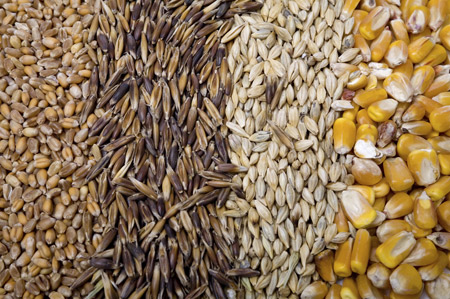 (Reuters) – U.S. corn futures fell on Monday, as investors braced themselves on the eve of a monthly U.S. Department of Agriculture report that analysts expected to project rising domestic corn stockpiles.
(Reuters) – U.S. corn futures fell on Monday, as investors braced themselves on the eve of a monthly U.S. Department of Agriculture report that analysts expected to project rising domestic corn stockpiles.
Wheat and soybeans followed corn lower, although forecasts for hot weather in the U.S. Midwest crop belt later this month underpinned the market.
At the Chicago Board of Trade, most-active December corn futures settled down 7 cents at $3.55-1/2 per bushel.
CBOT September wheat ended down 4-1/2 cents at $4.30-1/2 a bushel and benchmark November soybeans fell 2-3/4 cents at $10.55 a bushel.
Corn posted the biggest percentage move as traders weighed the threat of potentially stressful heat in late July against forecasts for welcome rains this week.
“The near-term forecast this week is not threatening…. We are going to have a big percentage of the corn crop pollinated by the end of this week,” said Don Roose, president of Iowa-based U.S. Commodities.
After the CBOT close, the USDA in its weekly crop report rated 76 percent of the U.S. corn crop in good to excellent condition, up from 75 percent a week earlier.
The USDA rated 71 percent of the U.S. soybean crop as good to excellent, up from 70 percent the previous week. Analysts on average had expected no change in ratings for either crop.
CBOT soybeans fell but gained relative to corn on inter-market spreads as traders prepared for the USDA’s monthly World Agricultural Supply and Demand Estimates (WASDE) report on Tuesday.
Analysts surveyed by Reuters expected the USDA on Tuesday to raise its forecast of 2015/16 and 2016/17 U.S. corn ending stocks, while lowering its forecast for 2015/16 U.S. soybean stocks.
So far in 2016, “You’ve seen the trade buys beans and sell corn before a report, and they are usually right,” said Mike Zuzolo, president of Global Commodity Analytics.
While U.S. corn inventories are expected to balloon above 2 billion bushels by the end of the 2016/17 marketing year, soybean stocks should be much tighter due to export demand from China and crop problems in South America.
As a result, the market is counting on strong U.S. yields to bolster soy production, making summer weather a key concern. August is the critical month for determine soy yields.
CBOT wheat fell in sympathy with corn, and as a strengthening dollar diminished already poor prospects for U.S. supplies on the export market.




